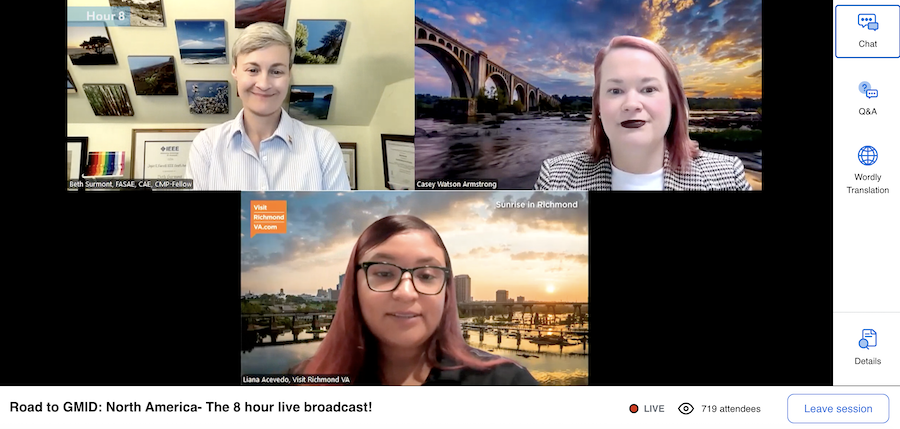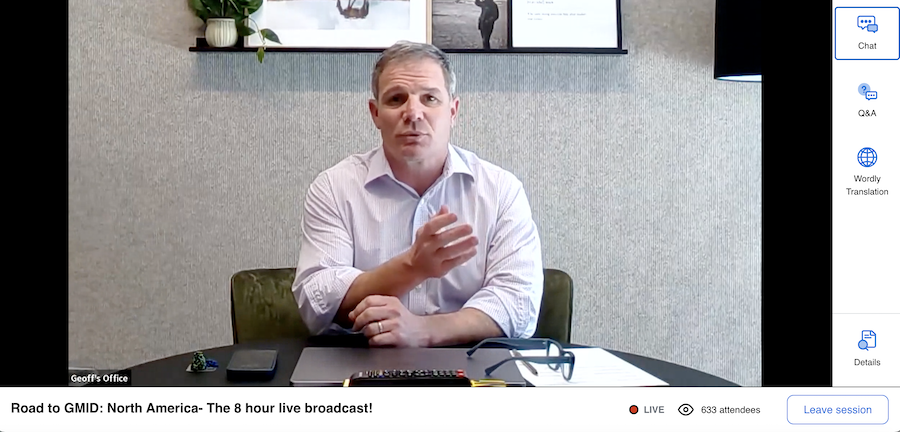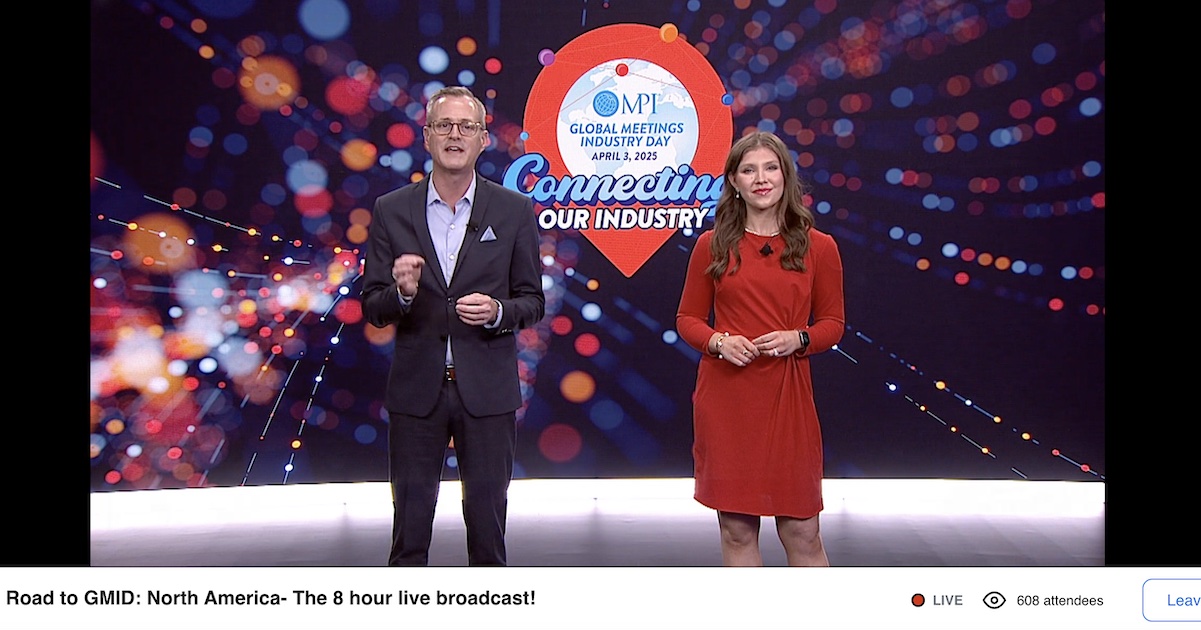Meetings and events are essential drivers of economic growth and innovation around the world, and MPI’s 2025 Global Meetings Industry Day (GMID) broadcast proved it. Today (April 3), a month of GMID educational opportunities concluded with a North America broadcast that followed weekly sessions from across the globe—Asia-Pacific/Australia, Europe, Africa and Central/South America—with 3,000 attendees participating in MPI’s online GMID celebrations this year.
Thanks to our partners Cvent, Grit Productions & Expositions and Wordly, attendees were able to earn up to 12 clock hours while gaining insights and takeaways from top industry leaders, connecting with peers/partners and rallying to support a profession we all love.
In case you missed it, below is a quick summary of some of the education highlights from the last hour of the broadcast alone. So imagine how much knowledge there is to glean from the full GMID experience (which you can find on demand here). We hope to see you next year!
Regenerative events
In the educational session “Regenerative Events: Moving Beyond Net Zero,” sponsored by Visit Richmond (Virginia), Beth Surmont, FASAE, CAE, CMP-Fellow, vice president of event strategy and design for 360 Live Media, said she was first exposed to the term “regenerative” through regenerative agriculture.
“If you’re not familiar with regenerative agriculture, you don’t just plant the same thing over and over, you actually take time to nurture the soil and you’re very intentional about the rotation of crops,” said Surmont, who was joined in the session by Liana Acevedo, CMP, director of destination services for Visit Richmond, and Casey Watson Armstrong, destination sales manager for Visit Richmond. “You’re really trying to think about how do you not just get the most out of something but put something back into it. And I love that concept with events because I have always been excited about local impact. We are in a place where we bring hundreds, maybe thousands of smart people together in one community at the same time. When we don't leave the four walls of the convention center or the hotel, we’re really leaving opportunity on the table for the local community and our attendees.”

Understanding that it’s increasingly difficult to get people to attend events because of other priorities and how much things cost, taking time to be intentional and incorporate regenerative concepts into your design helps you stand out from other events, Surmont said.
“There are a lot of different ways to do this,” she said. “There’s the financial way—you can use a tool like Social Offset to make donations to vetted local vetted charities on behalf of an event. You can also do local pop-up shops—I’m a huge fan of these. I’ve gotten to attend a couple of different events that did things like this. At Destinations international’s annual event last year in Tampa, they had a whole outside event where they brought in all these local vendors and people could go and shop and get an authentic gift, which I think is something that people are really looking for. At IAEE’s Expo Expo at the end of last year, they brought in a group of homeless women and taught them skills in how to run a business. The person working the shop told me her story: A few years ago, she was out on the street and now she has all these skills, and her own business.”
Event contracts
In advance of her keynote session “Navigating Event Contracts,” Cheryl Payne, CMP, CMM, strategic partner at INNOV8 Meetings + Events, polled some meeting planner friends to find out about some of the most important challenges she should address with the GMID audience.
One of the questions she was asked: “How can I negotiate better rates with hotels?” Payne said it’s essential to do your market research and source several similar-type hotels in the same area.
“This will help you evaluate what all hotels in the area are offering and also help you through the negotiation process,” she said. “If hotel A is offering lower rates than hotel B, you can negotiate them against each other.”
Having pattern or date flexibility also helps, Payne said.

“Shifting your program just one day forward or one day backwards can make a significant difference on the rates that a hotel is quoting,” she said. “It’s a hotel’s goal to maximize their full revenue, and if you shift your pattern back one day having your arrival, let’s say, on a Sunday versus a Monday, this can reduce your rate. It also allows the hotel to maximize their revenue for the week as far as placing groups.”
Payne said having historical data on previous spend and pickups and providing that data to the hotel also enhances your leveraging ability.
“What did you spend in previous years and what kind of revenues are you going to provide to the hotel in each category—and when I say in each category, I mean what kind of revenue are you going to provide the hotel with sleeping rooms, food and beverage spend and any ancillary spend? What are you going to spend at their restaurants, at their outlets?” she said. “Also during negotiations, consider offering a multi-year agreement and consider increasing your room block if you have that ability. Working with the hotel to come up with that common ground will definitely benefit you when it comes to negotiating better rates for your programs. Just be sure to compare multiple bids and utilize that as you’re negotiating with the hotel.”
State of travel
In the final GMID “State of the Industry” discussion, sponsored by Visit Tampa Bay, MPI President & CEO Paul Van Deventer and U.S. Travel Association President & CEO Geoff Freeman talked about the latest travel trends impacting the meeting and event industry.
Van Deventer asked Freeman about the “elephant in the room”: the actions of the Trump Administration that are impacting travel, whether intentionally or unintentionally.
“I think you just made an important distinction: the unintentional and the intended,” Freeman said. “When it comes to the intended side, we have a lot of opportunities with this administration. We’re working closely with people in the White House when it comes to improving the air traffic control system, giving people confidence in flying and creating a task force around the World Cup (which is coming next year) and all the things that need to happen for the World Cup to be a success—everything that’s important to us and the travel industry,” Freeman said. “On the intentional things, whether it’s with the Department of Transportation, the State Department or Homeland Security, we’re seeing some progress.”

The risk, Freeman said, is actions that might have unintended negative impacts on the travel industry.
“I saw an op-ed that ran in the Guardian yesterday that said if you want to make America pay, boycott travel to the United States,” he said. “That’s where we’re going to see challenges, where it’s a battle over tariffs, it’s a battle over other issues and travel becomes weaponized. There’s a lot of risk for us. It’s something we’re talking with the administration about. Are we going to change their economic policy or get them to back off on some of these other issues? I think we all know the answer to that. It’s a question of how do we capitalize in those intended areas. I’ll go back to the World Cup: If we’re going to make it a success, we’ve got to address air traffic control. We’ve got to address the TSA, as the system has become overwhelmed. We’ve got to address visas; we’ve got to address customs. I raise those things because we’re going to talk about them under the banner of the World Cup, but fixing each of those things is beneficial to the group segment. We’re just leaning into it in a way that resonates with this administration.”

